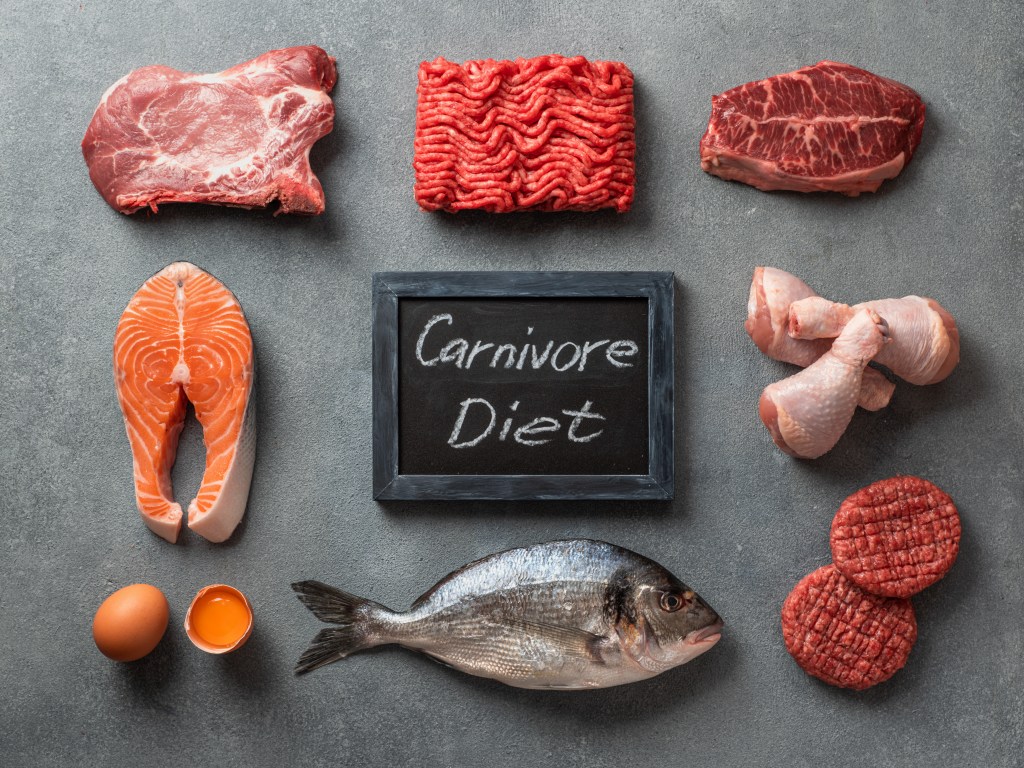Ketogenic and carnivore diets are popular meal plans that promote a healthy body weight and can help manage certain conditions, but what is the ketovore diet?
Ketovore is a combination of a traditional keto diet and a carnivore diet. It’s a high-fat and low-carb diet that focuses on consuming primarily animal products and some plant foods.
Learn more about ketovore and how it differs from keto, and discover this dietary approach’s potential health benefits and downsides.
What is the ketovore diet?
The keto-carnivore diet, widely known as ketovore, combines the carnivore and ketogenic diet.
Ketovore is more restrictive than keto and less stringent than carnivore but shares the same low-carb principles as both diets.
Ketovore aims to trigger and maintain ketosis. This metabolic state pushes the body to burn fat instead of glucose as a fuel source, which is achieved by consuming primarily meat, animal fats, and small amounts of low-carb vegetables.
Processed foods and foods high in sugar, starches, or carbohydrates are prohibited.
A ketovore food list might include the following:
- Meat
- Fish
- Lard
- Eggs
- Heavy cream
- Butter
- Avocados
- Coconut oil
- Leafy greens such as spinach, romaine, and arugula
- Low-carb vegetables, including broccoli, asparagus, and cauliflower
While carb-containing condiments such as ketchup or relishes must be avoided, low-carb spices, including basil, sage, salt, pepper, and thyme, can be used to season meats.
Watch the video below to learn more about diets high in animal products.
How is the ketovore diet different?
Ketovore is a modified version of keto and carnivore that uses the low-carbohydrate approach of both diets to promote weight loss, improve blood sugar control, reduce food cravings, and boost metabolic health.
Here’s a look at how ketovore differs from keto and a strict carnivore diet.
Ketovore vs. the ketogenic diet
The keto diet follows specific macronutrient ratios to put the body in ketosis. Keto is popular among those who want to achieve healthy weight loss, reduce the risk of heart disease, increase insulin sensitivity, or promote cognitive health.
Keto recommends that 70 percent of calories come from healthy fats, 20 percent from protein, and 10 percent from carbs.
Healthy Keto® is a balanced diet consisting of high dietary fat and moderate protein intake, limiting carbs and incorporating seven to ten cups of low-carb vegetables daily.
Compared to carnivore and ketovore, keto is the most flexible diet, allowing nuts, seeds, berries, cheeses, and various other low-carb foods.
It’s also the most well-researched and is used medically to help manage certain metabolic and neurological conditions, including type 2 diabetes and epilepsy.
Ketovore follows the basic principles of the ketogenic diet by aiming to achieve ketosis. However, like the carnivore diet, ketovore prioritizes animal products over low-carb plant foods.

Ketovore vs. carnivore
Carnivore is the ultimate elimination diet. It’s a high-protein, high-fat meal plan that focuses on eating only meat and animal-based foods such as eggs, bone marrow, organ meats, and animal fat.
Zero-carb seasonings, like salt and herbs, and low-lactose dairy products, including butter and heavy cream, are also allowed. Beverages other than water are typically prohibited on a carnivore diet.
Contrary to keto and ketovore, which aim to enter ketosis by limiting carb intake to no more than 50 grams daily, carnivore aims to eliminate all carbohydrates and potentially inflammatory foods.
Carnivore is thought to help manage autoimmune diseases, diabetes, and various intestinal disorders by excluding digestive irritants such as high-carb fruits and fibrous vegetables.
The ketovore meal plan is often viewed as a less restrictive version of the carnivore diet, as it promotes eating mostly animal products but does allow small amounts of low-carb vegetables.

5 benefits of the ketovore diet
A ketovore diet focusing on nutrient-dense whole foods may help you lose weight, improve eating habits, and promote digestive health.
Here are five potential benefits of a nutritious ketovore diet.
1. Boosts weight loss
Carbohydrates and sugars quickly spike blood glucose levels. This triggers the release of insulin, a metabolic hormone that signals cellular glucose uptake to keep blood sugar levels steady.
In addition to regulating blood sugar, insulin also promotes fat storage, which explains why a high-carb diet is a leading cause of weight gain and obesity.
A low carbohydrate diet such as ketovore restricts carbohydrate intake and, at the same time, pushes the body to utilize dietary fat and stored body fat to generate energy. This promotes metabolic health, crucial for weight loss and maintaining a healthy body weight.
2. May help manage autoimmune diseases
Though research is limited on the effects of high-fat diets and autoimmune conditions, anecdotal evidence suggests that temporarily increasing meat consumption could help improve inflammatory responses.
A study published in Current Developments in Nutrition investigated the effects of a carnivore diet and found that “50% of survey participants started the carnivore diet to improve allergic, skin, or autoimmune conditions, or digestive health, and many reported improvements in inflammatory conditions and related symptoms.”1

3. May improve gastrointestinal issues
Those with gastrointestinal (GI) issues such as intestinal permeability or irritable bowel syndrome (IBS) often have difficulties digesting fibrous vegetables and experience bloating, abdominal pain, and excessive gas.
“Consuming plenty of low-carb vegetables ensures you receive a range of nutrients,” explains Dr Berg. “However, people with digestive issues may benefit from temporarily eliminating or consuming fewer plants.”
Ketovore may help improve GI symptoms by reducing potentially irritating foods that are hard to digest.
Additionally, animal products contain various nutrients, such as collagen, glutamine, and gelatin, that have been found to improve digestive health by strengthening the gut lining.
4. Helps identify food sensitivities
Though not as strict as the carnivore diet, ketovore can serve as an elimination diet and help identify food sensitivities.
Those who eat a variety of foods and experience symptoms such as belly swelling and bloating, diarrhea, or digestive upset may benefit from the keto-carnivore diet.
Ketovore removes many foods that may lead to irritation, allowing dieters to gradually reintroduce individual foods, which helps monitor their effects.
5. Improved blood sugar control
Diets high in carbohydrates spike insulin, which can lead to blood sugar fluctuations, cravings, and insulin resistance.
Insulin resistance is typically linked to frequent eating and excessive carbohydrate intake and is a primary cause of obesity, metabolic syndrome, and diabetes.
Low-carb diets like ketovore may help improve insulin response by significantly reducing carbohydrate intake, which stabilizes blood sugars and enhances insulin signaling.

Downsides of the ketovore diet
Despite its weight loss benefits and potential to improve GI and autoimmune conditions, data on the long-term effects of mainly consuming animal products is limited.
Here are potential downsides to following a ketovore diet.
1. Cardiovascular concerns
High-protein diets may be associated with an increased risk of artery blockages, heart disease, stroke, and elevated low-density lipoprotein (LDL) cholesterol, widely known as bad cholesterol.
Research published in the Journal of the American Society of Nephrology found that high protein intake can contribute to cardiovascular events in the general population.2
2. Increased risk of kidney stones
Those who are susceptible to kidney stones may benefit from avoiding a ketovore diet. High protein intake has been linked to increased urinary calcium and oxalate formation, which can lead to kidney stones.
A study published in Clinical Science found that high-protein diets increased the risk of kidney stone formation by 250 percent.3

3. Constipation
Ketovore may not offer adequate amounts of vegetable fiber.
Fiber attracts water into the bowel, which softens and bulks out stool. This explains why a lack of vegetables can lead to constipation.
Additionally, a sudden high-fat intake can overwhelm a sluggish gallbladder, leading to poor digestive processes.
When fats are consumed, the gallbladder releases bile into the GI tract to facilitate fat digestion. Excessive intake of high-fat foods can overburden the gallbladder, resulting in incompletely digested fats and potential side effects such as constipation or foul-smelling stool.
4. Nutrient deficiencies
Eating animal products provides essential nutrients not found in plants, including vitamins A, B12, D3, and heme iron. However, ketovore diets may increase the risk of deficiencies in vitamins C and E and may not offer adequate calcium to promote healthy levels.
These nutrient deficiencies can cause mood disorders such as depression, skin issues, reduced bone strength, and poor immune functions.

Key takeaways
What is the ketovore diet? The ketovore diet is a modified version of the ketogenic and carnivore diets that focuses on high meat intake and small amounts of low-carb vegetables.
Though ketovore can induce ketosis, promote weight loss, and potentially help manage gastrointestinal and autoimmune conditions, it may not be sustainable in the long term.
A diet with a more balanced macronutrient ratio, such as healthy Healthy Keto, offers well-rounded nutrition while reaping the health benefits of a low-carb, high-fat diet.
FAQ
1. What foods can you eat on the ketovore diet?
The ketovore diet food list consists of meat, fish, eggs, low-carb dairy products, spices, and healthy fats like avocados, olives, and coconut. It also allows small amounts of low-carb vegetables, such as leafy greens and broccoli.
2. What can you drink on the ketovore diet?
Water, teas, and coffee with heavy cream or butter are allowed on the ketovore diet. However, unlike the ketogenic diet, those on ketovore typically avoid using sugar alternatives like stevia, monk fruit, or erythritol.
3. Can you eat salad on the ketovore diet?
Yes, salad is okay to eat when following ketovore since leafy greens are low in carbohydrates.
However, the keto-carnivore diet focuses on high-fat and high-protein foods, and adding meat and animal products can make salads more ketovore-friendly.
4. Will a ketovore diet put you in ketosis?
Yes, a ketovore diet can trigger ketosis as long as your daily net carb intake doesn’t exceed 20 to 50 grams.
Consuming more than 50 grams of net carbs will likely raise blood sugar and insulin levels and can kick you out of ketosis.
5. Can you eat carbs on the ketovore diet?
Yes, low-carb vegetables are allowed on the ketovore diet. Ketovore follows similar macronutrient guidelines as the ketogenic diet, and those on ketovore should limit carb intake to no more than 50 grams daily to maintain ketosis.
Sources
- https://pmc.ncbi.nlm.nih.gov/articles/PMC8684475/ ?
- https://pmc.ncbi.nlm.nih.gov/articles/PMC2723984/ ?
- https://portlandpress.com/clinsci/article-abstract/57/3/285/74756/ ?








